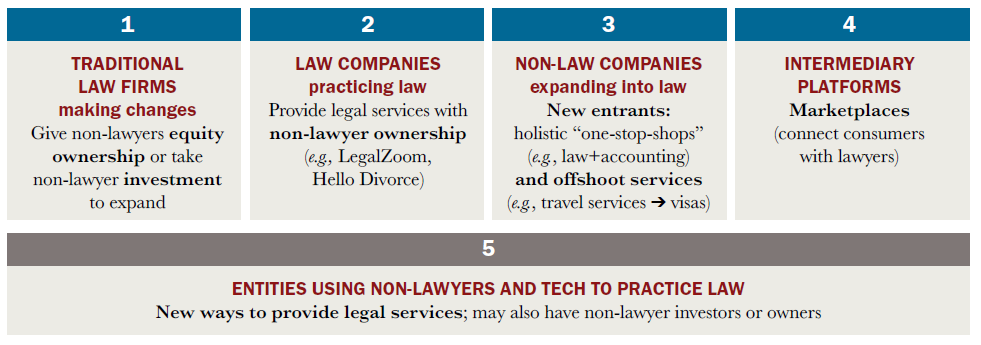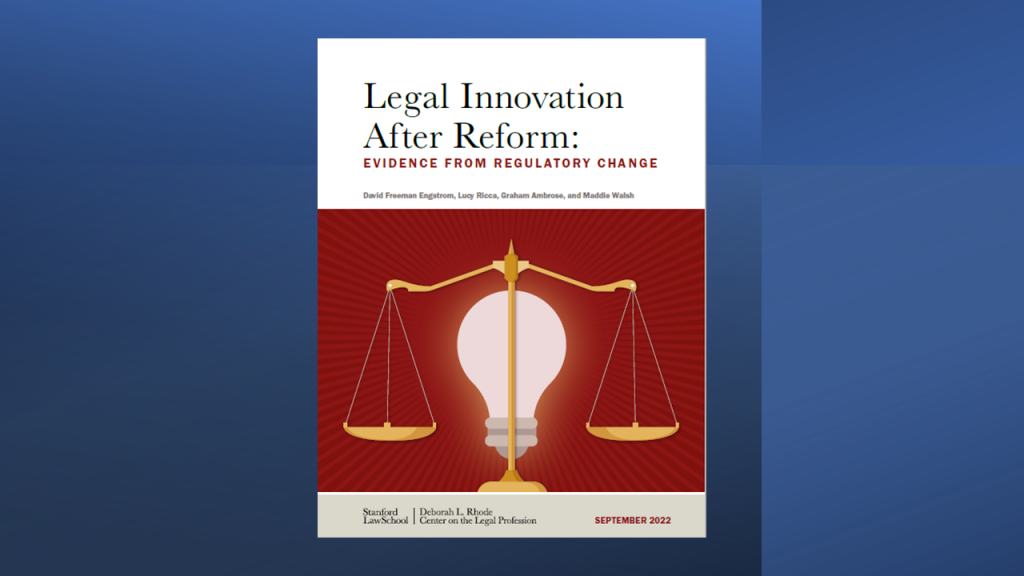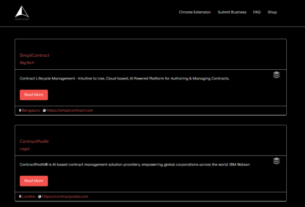A Stanford Law School study published today of regulatory reforms in Utah and Arizona finds that they are “spurring substantial innovation,” that they are critical to serving lower-income populations, and that they do not pose any substantial risk of consumer harm.
“The evidence gathered in this report shows that rule reforms can spur significant innovation, both in the ownership structure of legal services providers and in the delivery models used to serve clients,” the report concludes.
The comprehensive report was written by David Freeman Engstrom, co-director of the Deborah L. Rhode Center on the Legal Profession at Stanford, and Lucy Ricca, director, policy and programs at the Rhode Center and formerly executive director of the Utah Office of Legal Services Innovation — the office that oversees the so-called Utah sandbox.
Stanford Law students Graham Ambrose and Maddie Walsh also participated in writing the report.
The report, Legal Innovation After Reform: Evidence from Regulatory Change, set out to examine the impacts of regulatory reforms adopted in Arizona and Utah, where those states have relaxed or eliminated rules on who can practice law and own law firms.
(For more on these reforms, see: Breaking: In Historic Vote, Utah Supreme Court Approves Sweeping Changes in Legal Services Regulation and Arizona Is First State To Eliminate Ban On Nonlawyer Ownership Of Law Firms.)
Specifically, the authors set out to answer two questions:
- What types of innovation in legal services delivery models will different reform approaches generate?
- Who will be served by those innovations?
To find those answers, they pursued two lines of inquiry. First, they conducted in-depth, semi-structured interviews with 37 entities that have obtained authorization in liberalizing jurisdictions — half in Utah and Arizona and half in the U.K. Second, they conducted a comprehensive analysis of the applications, authorizations, and other public-facing materials from all 57 of the authorized entities in Utah and Arizona as of June 30, 2022.

The report described a taxonomy of five principle innovations being developed in Arizona and Utah.
Based on their study, they reach five conclusions (or “insights” as they call them):
- Regulatory reforms are spurring substantial innovation in five different ways. The study found a range of innovations, both in ownership structures and delivery models. More specifically, they identified five types of innovations: (1) traditional law firms making changes to their capital or business structure or service model, (2) “law companies” practicing law, (3) “non-law companies” as new entrants to the legal sector, (4) intermediary platforms, and (5) entities using nonlawyers and technology to practice law.
- Lawyers are playing a central role in the entities and the innovation within them. Although some in the legal profession view regulatory reform as a threat to lawyers, the report finds that, in Utah and Arizona, “lawyers remain central to the development and delivery of services.” Lawyers’ roles take various forms, with some as employee practitioners, others providing oversight and compliance, and still others providing entity ownership and leadership. In Utah, where services can be delivered entirely by nonlawyers and software, many traditional firms are now seeking authorization to offer tiered services at different price points, perhaps starting with DIY services and then moving up the scale to lawyer guidance.
- A majority of entities are using both technology and other innovations to deliver services in new ways, mostly to consumers and small businesses. Not surprisingly, technology is a critical element in innovation of legal services delivery. In total, 61% of the approved entities in Arizona and Utah identified a technological innovation as part of their model. In both sates, most of these authorized entities are serving consumers and small businesses — 84 percent, or 48 entities — report providing services to consumers and small businesses.
- UPL reform appears to be critical to serving lower-income populations. The Utah sandbox — which allows entities to seek waivers of UPL rules regarding the unauthorized practice of law — contains the only entities, all of them non-profits, that primarily serve indigent and low-income people, the report finds. By contrast, Arizona’s “ABS-only approach” is thus far yielding important but limited changes to the conventional law firm model of legal services delivery that predominantly serves a middle-income and small business clientele.
- Reform efforts to this point do not appear to pose a substantial risk of consumer harm. A key argument of opponents of regulatory reform is that it will harm consumers. But the report finds that authorized entities in Utah and Arizona do not draw a substantially higher number of consumer complaints, as compared to lawyers. Utah’s June 2022 data report one complaint per 2,123 services delivered, while Arizona received no complaints.
It is important, the report suggests, that as other states consider regulatory reforms, their decision-making is informed by data such as this report contains.
“Though these insights are subject to caveats, they provide us with data-based insight into the realities of liberalizing the rules around ownership of legal businesses and the practice of law,” the authors write. “Those realities can and should inform and drive policymaking going forward.”
A key finding of the report is that the different approaches taken by Utah and Arizona to regulatory reform are yielding different results. Arizona’s reform targeted Rule 5.4 of the Model Rules of Professional Conduct, eliminating it to allow those other than lawyers to invest in so-called alternative business structures (ABS). Utah’s sandbox both allows investments in law firms and also loosens the rules around who the unauthorized practice of law, allowing those other than lawyers to deliver services.
The Utah approach — which the report calls “ABS+UPL” — is more likely than the ABS-only approach to have an impact on access to justice, the authors conclude.
“An ABS+UPL approach, in which regulated entities not only can access new sources of capital but can also develop service innovations that deploy nonlawyers and technology, is more likely to see nonprofit participation, more likely to spur creation of lower-cost service tiers, and more likely to impact the justice gap for low-income individuals, where access concerns are typically most acute,” they write. “Other states considering regulatory reform should recognize that their regulatory choices will impact the outcomes of reform.”
The full report goes into much greater depth in describing the research and findings, including discussing specific entities providing services in Utah and Arizona.

